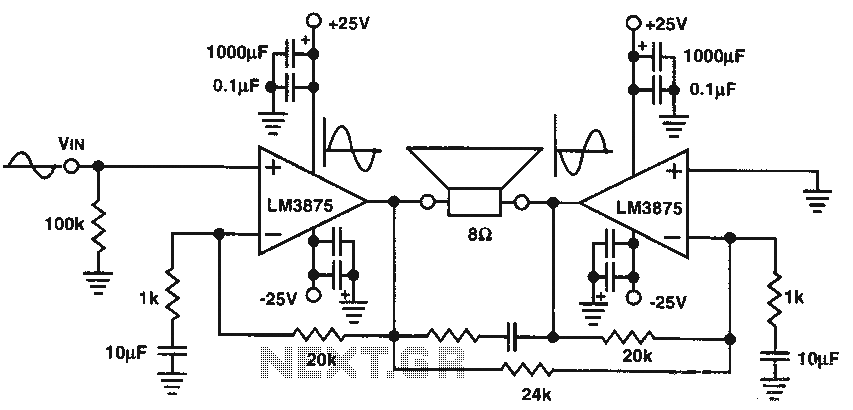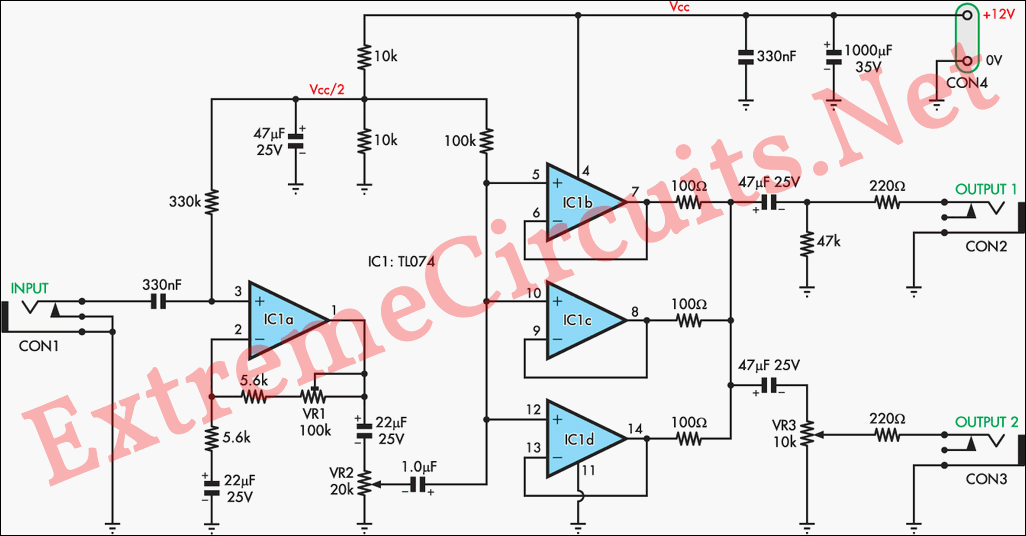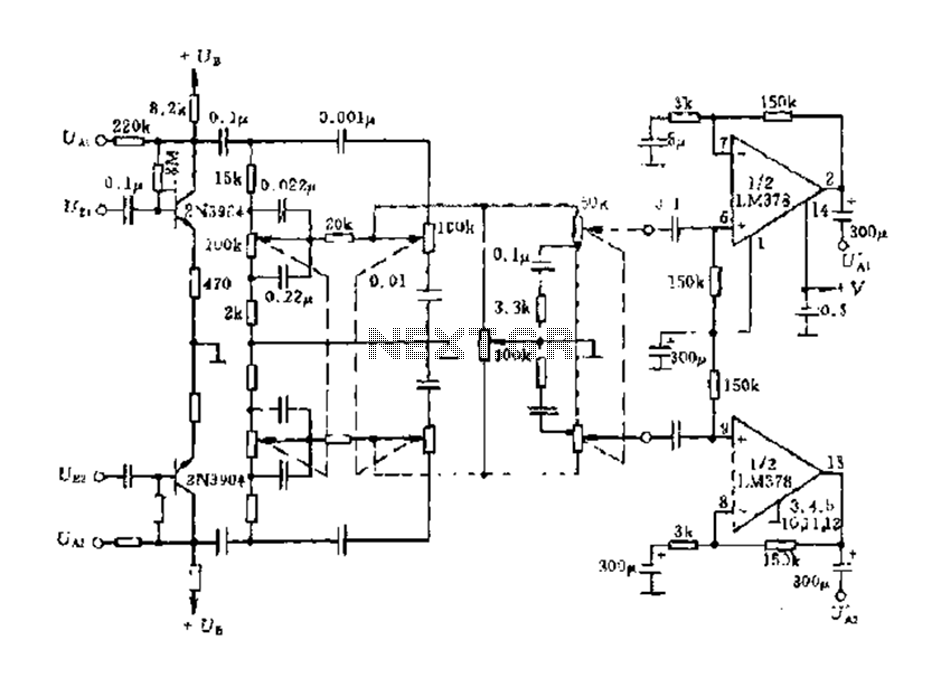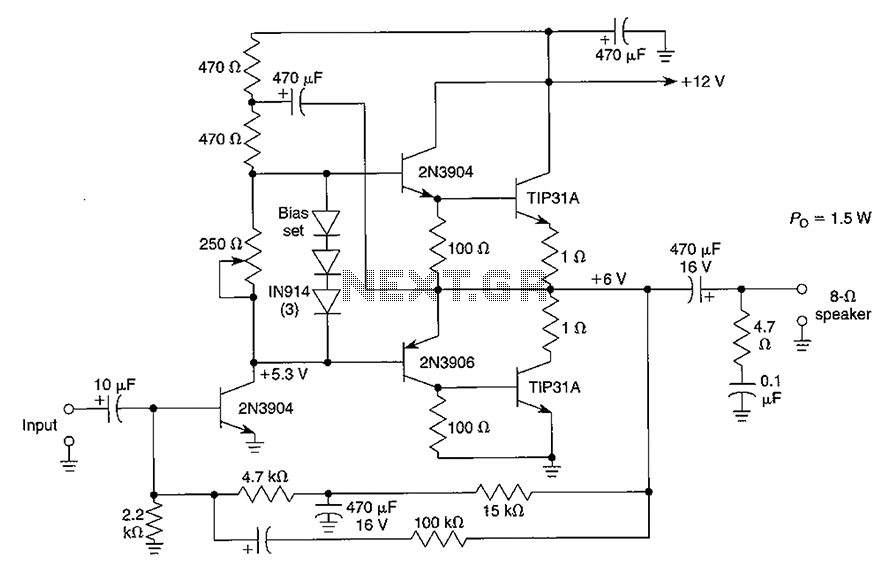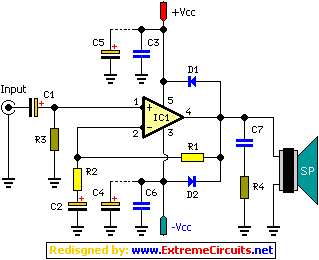
20 Watt Stereo Amplifier with TDA2005
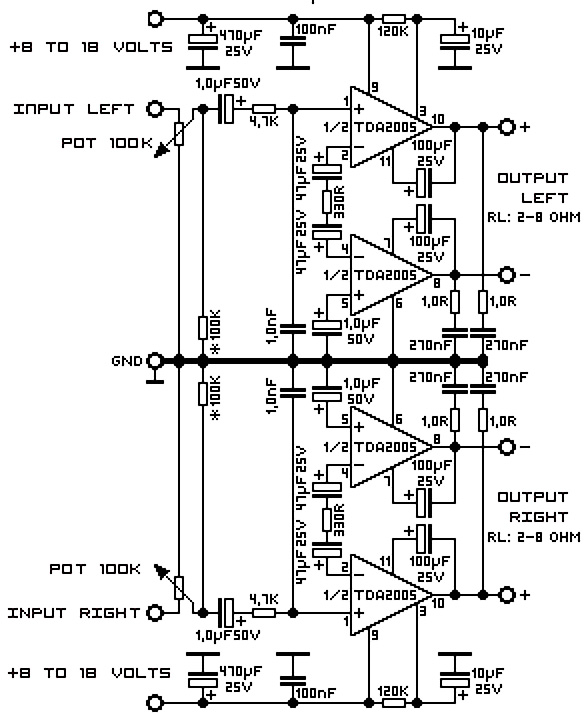
A 20W TDA2005 stereo amplifier designed for various applications, including the amplification of medium power speakers. It is suitable for automotive use; however, the power supply must be equipped with a choke of at least 150mH and should provide approximately 6 to 7 amps during operation.
The TDA2005 amplifier is a versatile audio amplification solution that operates efficiently in a variety of settings, particularly in automotive applications where space and power efficiency are critical. Its design allows it to deliver a continuous output power of 20 watts per channel into an 8-ohm load, making it ideal for medium power speakers commonly found in vehicles.
To ensure optimal performance, the power supply configuration is crucial. The recommendation for a choke of at least 150mH is intended to filter out high-frequency noise and stabilize the power supply, which is essential for maintaining audio clarity and preventing distortion. The choke acts as an inductor that smoothens the current supplied to the amplifier, particularly during dynamic audio signals that require rapid changes in power.
Furthermore, the requirement for the power supply to deliver 6 to 7 amps indicates that the amplifier is capable of handling significant current demands, particularly during peaks in audio output. This characteristic is vital for maintaining sound quality and preventing clipping, which can occur if the amplifier is pushed beyond its power supply limits.
The TDA2005 circuit typically comprises several key components, including input capacitors for signal coupling, gain-setting resistors, and feedback networks that stabilize the amplifier's operation. Proper thermal management is also essential, as the amplifier can generate heat during prolonged use. Adequate heat sinking or ventilation should be considered in the design to prevent overheating and ensure longevity.
In summary, the TDA2005 stereo amplifier is an effective solution for medium power audio amplification, particularly in automotive scenarios, provided that the power supply is appropriately configured to meet the specified inductance and current requirements.20W TDA2005 stereo amplifier for all suitable applications like amplifying medium power speakers. It is suitable for car use but before, the power supply must be choked with at least 150mH and it must give up to approximately 6 to 7 amps during the upstream performance 🔗 External reference
The TDA2005 amplifier is a versatile audio amplification solution that operates efficiently in a variety of settings, particularly in automotive applications where space and power efficiency are critical. Its design allows it to deliver a continuous output power of 20 watts per channel into an 8-ohm load, making it ideal for medium power speakers commonly found in vehicles.
To ensure optimal performance, the power supply configuration is crucial. The recommendation for a choke of at least 150mH is intended to filter out high-frequency noise and stabilize the power supply, which is essential for maintaining audio clarity and preventing distortion. The choke acts as an inductor that smoothens the current supplied to the amplifier, particularly during dynamic audio signals that require rapid changes in power.
Furthermore, the requirement for the power supply to deliver 6 to 7 amps indicates that the amplifier is capable of handling significant current demands, particularly during peaks in audio output. This characteristic is vital for maintaining sound quality and preventing clipping, which can occur if the amplifier is pushed beyond its power supply limits.
The TDA2005 circuit typically comprises several key components, including input capacitors for signal coupling, gain-setting resistors, and feedback networks that stabilize the amplifier's operation. Proper thermal management is also essential, as the amplifier can generate heat during prolonged use. Adequate heat sinking or ventilation should be considered in the design to prevent overheating and ensure longevity.
In summary, the TDA2005 stereo amplifier is an effective solution for medium power audio amplification, particularly in automotive scenarios, provided that the power supply is appropriately configured to meet the specified inductance and current requirements.20W TDA2005 stereo amplifier for all suitable applications like amplifying medium power speakers. It is suitable for car use but before, the power supply must be choked with at least 150mH and it must give up to approximately 6 to 7 amps during the upstream performance 🔗 External reference
